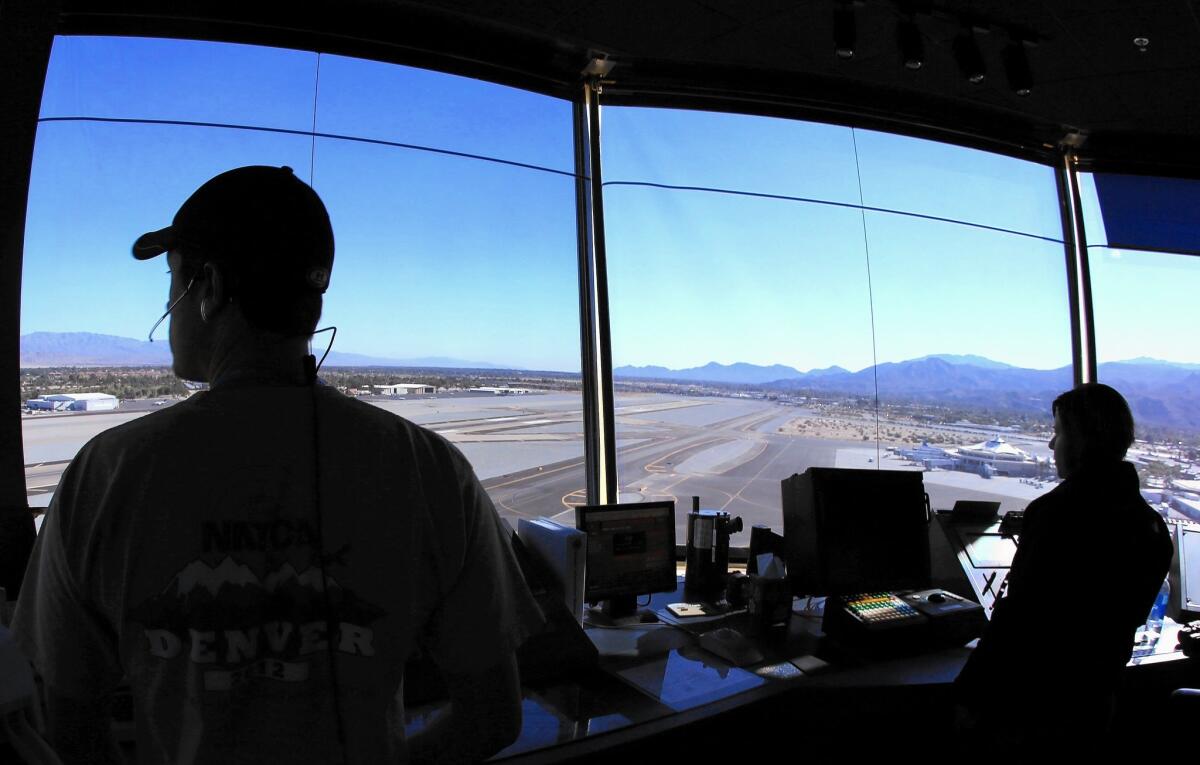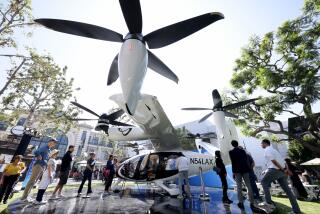FAA proposes state-of-art traffic control system for L.A.âs crowded skies

High above the 22 million people who live and work in Southern California is some of the busiest airspace in the nation.
On a typical day, more than 11,000 aircraft take to the skies, most of them over the sprawling Los Angeles Basin.
There are Gulfstream jets from Van Nuys Airport, Cessna 172s from Santa Monica Airport, helicopters from Torrance Municipal and giant Boeing 747s from Los Angeles International, which handles more than 1,700 departures and arrivals daily.
Keeping track of it all is a massive undertaking for air traffic controllers, who use radar screens dotted with moving lights to guide aircraft to their destinations; technology that dates to the 1950s.
The Federal Aviation Administration now believes there is a better way to manage the crowded sky.
The agency is proposing a state-of-the-art air traffic control system that would track aircraft more precisely, potentially freeing up congested corridors and allowing pilots to make shorter, safer flights to their destinations.
For passengers, the anticipated benefits include less time in the air, reduced taxiing times and the elimination of long delays on the tarmac or at terminal gates. Nationally, flight delays and cancellations cost travelers an estimated $16.7 billion a year, roughly the same amount as air carriers.
The planned Metroplex program â one of 14 in the nation â is the local application of procedures and technology from the FAAâs sweeping NextGen project.
NextGen, which will cost the government and airline industry at least $32 billion and take years to implement, is an ambitious effort to modernize the air traffic control system.
The project is gradually replacing radar-based flight monitoring with more sophisticated automation and global positioning satellites. The technology will enable controllers â and eventually pilots â to know exactly where aircraft are at all times instead of waiting every nine to 12 seconds for radar signals to bounce back.
FAA officials say the Southern California proposal involves 109 new satellite-related procedures, involving 50 departure routes, 37 arrival routes and 22 approach procedures that guide flights down until they are very close to their destination airports.
âWe are transitioning from a radar-based system to a satellite-based system,â said FAA Administrator Michael Huerta. âThis set of technologies will give us better efficiency, better fuel burn, environmental benefits and improved safety.â
When the systems are in place, air traffic controllers will be able to create more precise flight paths, keep aircraft routes separated automatically and reduce radio communications with pilots because instructions can be easily downloaded into onboard flight computers. The measures also would let controllers space aircraft closer together during takeoffs, landings and flights â meaning airports could handle more traffic.
By 2020, the cockpits of all commercial and general aviation aircraft using certain airspace must be equipped with some of the same NextGen technology air traffic control will be using.
As a result, FAA officials say aircraft will be able to fly more direct routes, reducing travel times, fuel consumption and air pollution.
Though the fuel savings and emissions data for the Southern California program are still being calculated, positive results have been reported at several airports, including Seattle-Tacoma International.
Alaska Airlines, for example, estimates that the procedures can save 2.1 million gallons of fuel annually and reduce carbon emissions by 22,000 metric tons â the equivalent of taking 4,100 cars off the road every year.
The potential benefits are of particular value in heavily urbanized areas with complicated airspace, such as greater Los Angeles, which has five commercial airports and more than two dozen general aviation facilities as well as military air bases.
âThese are all good things they are working on,â said Jon Russell, an airline pilot who is the West Coast safety coordinator for the Air Line Pilots Assn. âThere will be lower workloads for pilots, less noise on descents and more precise departures and arrivals.â
Russell said, however, that the tighter spacing of aircraft will increase reliance on automated flight systems, raising the possibility that pilots could lose some of their manual flying skills over time.
Some positive results have already been reported by some of the nationâs airports.At Hartsfield-Jackson Atlanta International Airport, 12 more planes per hour can depart, reducing wait times for travelers. In Las Vegas, FAA officials say the new systems have cut the time it takes to land by 10 minutes.
The new systems have not been without controversy. According to recent congressional testimony, there have been significant delays in the modernization effort and at least $4.2 billion in cost increases. A recent Government Accountability Office survey of 70 industry stakeholders found that only 13 thought the FAAâs overall implementation of NextGen was going well.
âWe understand the importance of NextGen and are passionate about it,â Nicholas E. Calio, president and chief executive of Airlines4America, told Congress last November. âRegrettably, we have little to show for the $5 [billion] to $6 billionâ that has been spent on NextGen so far.
Huerta, the FAA administrator, said the modernization effort has âmade major progressâ and has already saved the airlines and passengers about $1.6 billion. An estimated $11.4 billion could be saved during the next 15 years, he added.
Earlier this month, Phoenix officials sued the FAA over increased aircraft noise in neighborhoods surrounding the cityâs international airport. They allege the noise is due to new flight paths designed for the NextGen project.
In Northern California, residents of Woodside and Portola Valley also are concerned about aircraft noise. They have asked a federal appeals court to review the environmental analysis for air traffic control improvements.
As a matter of policy, FAA officials do not comment on pending lawsuits. Ian Gregor, an FAA spokesman in Los Angeles, said, however, that âthousands of procedures have been implemented seamlessly across the nation. Only a handful have become controversial.â
After environmental assessments are finished, FAA officials plan to start the new procedures in Southern California next year. The rest of the program would be phased in gradually. The FAA also has scheduled 11 public workshops about the Metroplex project from San Diego to Santa Barbara from June 16 to July 1.
Last week, the agency released a draft environmental assessment of the proposal, which concluded there would be no significant noise effects. The public has until July 10 to comment on the analysis.
Follow @LADeadline16 on Twitter for transportation and aviation news.
More to Read
Sign up for Essential California
The most important California stories and recommendations in your inbox every morning.
You may occasionally receive promotional content from the Los Angeles Times.










